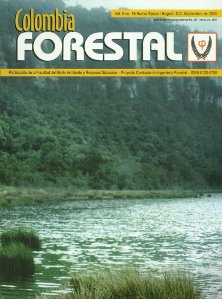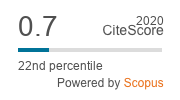DOI:
https://doi.org/10.14483/udistrital.jour.colomb.for.2003.1.a08Publicado:
01-01-2003Número:
Vol. 8 Núm. 16 (2003)Sección:
Artículos de investigación científica y tecnológicaPATRONES DE FRECUENCIA Y ABUNDANCIA DE SISTEMAS DE DISPERSIÓN DE PLANTAS EN BOSQUES COLOMBIANOS Y SU RELACIÓN CON LAS REGIONES GEOGRÁFICAS DEL PAÍS
Patterns of frequency and abundance of plant dispersal systems in Colombian forests and its relationship with the geographical regions of the country
Palabras clave:
Endozoochory, anemochory, synzoochory, relative frequency, relative abundance, Importance Value Index IVI. (en).Palabras clave:
abundancia relativa, anemocoria, endozoocoria, frecuencia relativa, índice de valor de importancia, afinidades florísticas, sinzoocoria (es).Descargas
Resumen (es)
El estudio de los sistemas de dispersión de las plantas permite entender la regeneración de los bosques, la dinámica poblacional de las plantas y las relaciones ecológicas que emergen dentro de los ecosistemas. En el presente estudio analizamos los patrones de sistemas de dispersión de semillas para Colombia, en relación con las regiones geográficas Amazónica, Andina, Caribe, Magdalena Alto, Magdalena Medio, Orinoquía y Pacífica. A partir de la información sobre la identidad y abundancia de plantas encontradas en 101 parcelas de vegetación de 1-ha, se exploraron los cambios en la frecuencia relativa y abundancia relativa de sistemas de dispersión entre las regiones geográficas. Adicionalmente, se determinaron las afinidades florísticas entre las regiones, así como la representatividad de las familias y géneros por sistema de dispersión. La endozoocoria fue altamente representativa en diferentes niveles taxonómicos (especie, género y familia), y su representatividad cambió entre las distintas regiones geográficas. Estos cambios podrían explicarse a partir de diferencias ecológicas entre las regiones.
Resumen (en)
The study of plant dispersal systems allows to go in depth in aspects that define the regeneration of forests, being essential to understand not only the population dynamics of plants but also the ecological relationships that emerge within ecosystems. In Colombia there is not a broad scale study showing the patterns of frequency and abundance of dispersal systems in different geographical regions (Amazonian, Andean, Caribbean, Upper Magdalena, Middle Magdalena, Orinoco, Pacific). Based on information of the identity and abundance of plants found in 101 vegetation plots of 1-ha, we explored the differences and associations in the frequency and abundance of dispersal systems between geographic regions. Additionally, we explored the importance value of families and genera per dispersal system, and the association between genera and geographic regions. The results show that environmental factors would be more important than the biogeographic history of the region in determining patterns of dispersal systems, reinforcing the importance of seed dispersal mediated by animals in tropical forests of different biogeographic regions.Referencias
Aldana, A.M., Beltrán, M., Torres-Neira, J., & Stevenson, P.R. (2008). Habitat characterization and population density of brown spider monkeys (Ateles hybridus) in Magdalena Valley, Colombia. Neotropical Primates, 15(2), 46-50.
Almeida-Neto, M., Campassi, F., Galetti, M., Jordano, P., & Oliveira-Filho, A. (2008). Vertebrate dispersal syndromes along the Atlantic forest: broad-scale patterns and macroecological correlates. Global Ecology and Biogeography, 17(4), 503-513.
Butler, D.W., Green, R.J., Lamb, D., McDonald, W.J.F., & Forster, P.I. (2007). Biogeography of seed-dispersal syndromes, life-forms and seed sizes among woody rain-forest plants in Australia’s subtropics. Journal of Biogeography, 34(10), 1736-1750.
Campbell, G., & Skillings, J.H. (1985). Nonparametric stepwise multiple comparison
Procedures. Journal of the American Statistical Association, 80, 998-1003.
Cano, A., & Stevenson, P.R. (2009). Diversidad y composición florística de tres tipos de bosque en la Estación Biológica Caparú, Vaupés. Colombia Forestal, 12, 63-80.
Chao, A., Chazdon, R.L., Colwell, R.K., & Shen T.-J. (2005). A new statistical approach for assessing compositional similarity based on incidence and abundance data. Ecology Letters, 8, 149-159.
Colwell, R.K. (2013). EstimateS: Statistical estimation of species richness and shared species from samples, Version 9. User's Guide and application published at: http://purl.oclc.org/estimates.
Connell, J.H. (1971). On the role of natural enemies in preventing competitive exclusion in some marine animals and in rain forest trees. En P.J. Den Boer & G.R. Gradwell (eds.). Dynamics of populations (pp. 298-312). Wageningen: PUDOC.
Correa-Gómez, D.F., & Stevenson, P.R. (2010). Estructura y diversidad de bosques de galería en una sabana estacional de los Llanos Orientales colombianos (Reserva Tomo Grande, Vichada). Orinoquia, 14(supl. 1), 31-48.
Curtis, J.T., & McIntosh, R.P. (1951). An upland forest continuum in the prairie forest border
region of Wisconsin. Ecology, 32(3), 476-496.
Gentry, A.H. (1982). Neotropical floristic diversity: phytogeographical connections between Central and South America, Pleistocene climatic fluctuations, or an accident of the Andean orogeny?. Annals of the Missouri Botanical Garden, 69(3), 557-593.
Gentry, A.H. (1983). Dispersal ecology and diversity in Neotropical forest communities. En K. Kubitzki (ed.). Dispersal and distribution: An international symposium (pp. 303-314). Hamburg: Paul Parey.
Gentry, A.H. (1993). A field guide to the families and genera of woody plants of Northwest South America (Colombia, Ecuador, Peru), with supplementary notes on herbaceous taxa. Washington: Conservation International. 895 p.
Hernández, J. (1992). Caracterización geográfica de Colombia. En G. Halffter (ed.). La diversidad biológica de Iberoamérica I (pp. 45-53). Xalapa: Acta Zoológica Mexicana.
Hernández, J., & Sánchez, H. (1992). Biomas terrestres de Colombia. En G. Halffter (ed.). La diversidad biológica de Iberoamérica I (pp. 153–173). Xalapa: Acta Zoológica Mexicana.
Hernández, J., Walschburger, T., Ortiz, R., & Hurtado, A. (1992). Origen y distribución de la biota suramericana y colombiana. En G. Halffter (ed.). La diversidad biológica de Iberoamérica I (pp. 55–103). Xalapa: Acta Zoológica Mexicana.
Hilty, S.L., & Brown, W.L. (1986). A guide to the birds of Colombia. Princeton: Princeton University Press. 836 p.
Howe, H.F., & Smallwood, J. (1982). Ecology of seed dispersal. Annual Review of Ecology and Systematics, 13, 201-228.
IBM Corp. (2011). IBM SPSS Statistics for Windows, Version 20.0. Armonk: IBM Corp.
Janzen, D.H. (1970). Herbivores and the number of tree species in tropical forests. The American Naturalist, 104, 501-528.
Jordano, P. (2000). Fruits and frugivory. En M. Fenner (ed.). Seeds: The ecology of regeneration in plant communities (2nd ed.) (pp. 125-165). Wallingford: CABI Publishing.
Mittermeier, R.A., Mittermeier, C.G., & Robles, P. (1997). Megadiversidad: Los países biológicamente más ricos del Mundo. México: Cemex. 501 p.
Moles, A.T., Ackerly, D.D., Tweddle, J.C., Dickie, J.B., Smith, R., Leishman, M.R., Mayfield, M.M., Pitman, A., Wood, J.T., & Westoby, M. (2007). Global patterns in seed size. Global Ecology and Biogeography, 16(1), 109-116.
Nathan, R., & Muller-Landau, H.C. (2000). Spatial patterns of seed dispersal, their determinants and consequences for recruitment. Trends in Ecology & Evolution, 15(7), 278-285.
Nuñez-Iturri, G., Olsson, O., & Howe, H.F. (2008). Hunting reduces recruitment of primate-dispersed trees in Amazonian Peru. Biological Conservation, 141(6), 1536-1546.
Pennington, T.D., Reynel, C., & Daza, A. (2004). Illustrated guide to the trees of Peru. Sherborne: DH books. 848 p.
Ridley, H.N. (1930). The dispersal of plants throughout the world. Ashford: Reeve. 744 p.
Stevenson P.R., Quiñones, M.J., & Castellanos, M.C. (2000). Guía de frutos de los bosques del Río Duda, La Macarena, Colombia. Bogotá: Asociación para La Defensa de La Macarena – IUCN. 467 p.
Stevenson, P.R., Suescún, M., & Quiñones, M.J. (2004). Characterization of forest types at the CIEM, Tinigua Park, Colombia. Field Studies of Fauna and Flora La Macarena Colombia, 14, 1-20.
Stevenson, P.R., & Aldana, A.M. (2008). Potential effects of Ateline extinction and forest fragmentation on plant diversity and composition in the western Orinoco basin, Colombia. International Journal of Primatology, 29(2), 365-377.
Stevenson, P.R., & Rodríguez, M.E. (2008). Determinantes de la composición florística y efecto de borde en un fragmento de bosque en el Guaviare, Amazonía colombiana. Colombia Forestal, 11, 5-17.
Stevenson, P.R., Suescún, M., Aldana, A.M., Cano, A., Umaña, M.N., Correa, D., Casas, L.F., & Villanueva, B. (2012). Diversidad arbórea en bosques de tierras bajas en Colombia: Efectos del ambiente, las perturbaciones y la geografía. Hipótesis, 12, 29-35.
Tabarelli, M., Vicente, A., & Barbosa, D.C.A. (2003). Variation of seed dispersal spectrum of woody plants across a rainfall gradient in north-eastern Brazil. Journal of Arid Environments, 53(2), 197–210.
Terborgh, J., Nuñez-Iturri, G., Pitman, N.C.A., Cornejo, F.H., Alvarez, P., Swamy, V., Pringle, E.G., & Paine, C.E.T. (2008). Tree recruitment in an empty forest. Ecology, 89(6), 1757-1768.
Ter Steege, H., Sabatier, D., Castellanos, H., van Andel, T., Duivenvoorden, J., de Oliveira, A.A., Ek, R., Lilwah, R., Maas, P., & Mori, S. (2000). An analysis of the floristic composition and diversity of Amazonian forests including those of the Guiana Shield. Journal of Tropical Ecology, 16(6), 801-828.
Umaña, M.N., Norden, N., Cano, A., & Stevenson, P.R. (2012). Determinants of plant community assembly in a fine-grained mosaic of landscape units in Central Amazonia: ecological and phylogenetic perspectives. PLoS ONE, 7(9), e45199.
Vallejo-Joyas M.I., Londoño-Vega, A.C., López-Camacho, R., Galeano, G., Álvarez-Dávila, E., & Devia-Álvarez, W. (2005) Establecimiento de parcelas permanentes en bosques de Colombia. Bogotá: Instituto de Investigación de Recursos Biológicos Alexander von Humboldt. 310 p.
van der Pijl, L. (1972). Principles of dispersal in higher plants (2nd ed.). Nueva York: Springer-Verlag. 162 p.
van Roosmalen, M.G.M. (1985). Fruits of the Guianan Flora. Wageningen: Institute of Systematic Botany, Utrecht University. 483 p.
Westoby, M., Leishman, M. & Lord, J. (1996). Comparative ecology of seed size and dispersal. Philosophical Transactions of the Royal Society B: Biological Sciences, 351, 1309–1318.
Westoby, M., Falster, D.S., Moles, A.T., Vesk, P.A., & Wright, I.J. (2002). Plant ecological strategies: some leading dimensions of variation between species. Annual Review of Ecology and Systematics, 33, 125–159.
Willson, M.F., Irvine, A.K., & Walsh, N.G. (1989). Vertebrate dispersal syndromes in some Australian and New Zealand plant communities, with geographic comparisons. Biotropica, 21(2), 133-147.
Wright, S.J. (2003). The myriad consequences of hunting for vertebrates and plants in tropical forests. Perspectives in Plant Ecology, Evolution and Systematics, 6(1), 73-86.
Young, K.R., Ulloa, C., Luteyn, J.L., & Knapp, S. (2002). Plant evolution and endemism in Andean South America: an introduction. The Botanical Review, 68(1), 4-21.
Cómo citar
APA
ACM
ACS
ABNT
Chicago
Harvard
IEEE
MLA
Turabian
Vancouver
Descargar cita
Licencia
Colombia Forestal conserva los derechos patrimoniales (copyright) de las obras publicadas, y favorece y permite la reutilización de las mismas bajo la licencia Creative Commons Atribución-CompartirIgual 4.0 Internacional por lo cual se pueden copiar, usar, difundir, transmitir y exponer públicamente, siempre que:
Se reconozcan los créditos de la obra de la manera especificada por el autor o el licenciante (pero no de una manera que sugiera que tiene su apoyo o que apoyan el uso que hace de su obra).














